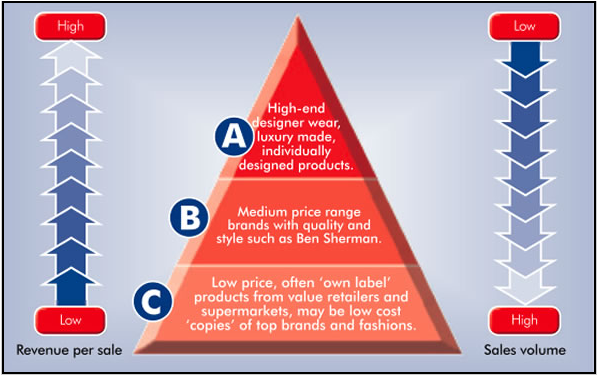Introduction
To discuss retail marketing and logistics issues, the selected retail company is Ben Sherman. This report will observe the current positioning strategy of this company and illustrates the current competitive environment, SWOT and PEST analysis, BCG matrix, considered the concept of marketing logistics as well as recommends future strategies to the management team.
Company overview
Ben Sherman is a renowned brand for men women and children’s clothing in almost 35 countries. In 1946 a British citizen Arthur Bernard Sugarman had established the company as a British company in Brighton. In the same year, he was migrated to the united states of America. In America, he got married to a daughter of an American cloth producer. He got tremendous support from his father-in-law and backed to Brighton at his factory of shirts. Sugarman’s continuous effort turned his brand into a world-famous brand and expanded in America, Australia, and Europe.
In 2004, An US company market leader of clothing retailer Oxford Industries Inc has purchased the Ben Sherman brand and company. Oxford Industries Inc has purchased the brand. Oxford Industries Inc is an apparel design company as well as a marketing and sourcing company. The brand Ben Sherman ranked at fourth place for and biggest laid-back wear brand in the United Kingdom, USA, Europe its growth is partially outstanding to the change in musical experience as a part of Ben Sherman’s marketing strategy.
Positioning strategy, selection of target market and develop marketing mix strategy
Kotler, P., and Armstrong, G. (2006) argued that retailers first should define their target markets and at that time it should decide how they will position themselves in these target markets. They also mentioned that until retailers define and profile their markets, they cannot construct consistent decisions about product assortment, their services, pricing strategy, advertising, distribution channels, store décor, or any of the other decisions, which must support these retailers’ positions. However, successful retailers define their target markets well as well as position themselves strongly.
- Market segmentation: Ben Sherman must decide first which segments offer the best opportunity for achieving its objectives to increase sales and profit by creating long-run customer relationships. Its market segments will consist of buyers with different needs, characteristics, or behavior who might require separate products or marketing programs. In this regard, Ben Sherman can prepare market segmentation in terms of:
- Customers want stylish apparel regardless of the price.
- Customers who care mainly about price or middle-class customers.
- Customers who think to get high quality at a reasonable price.
- Target Market: Young customers (18-30 year-olds) are the main target customer of Ben Sherman. However, they designed footwear for teenagers to middle-aged men and women, and their age ranges mainly 19-35 year-olds.
- Market positioning: Ben Sherman can position its items in a clear, distinctive, and particular way in the target customer’s mind relative to the competitors, by using a perfect positioning module. Thus, it should express the distinct benefits and features of the items in the target markets. Thus it can position the cosmetics goods as the best quality and reliable appliances. According to the annual report of Oxford Industries, Ben Sherman holds the premium market positions
- Product line: The Product line of Ben Sherman has been included children’s dress, men’s and women’s clothing with the full range of tailored and sportswear. Most of them are made of cotton, wool, and synthetic fiber or mixed fiber with their dignity and standards.
- Price: the price of Ben Sherman’s products is varied product-wise and the price is higher than other companies for their goodwill, brand identity. However, they give exclusive offers for customers. They provide a 20% discount for the autumn and winter seasons. It manufactures generally medium-price range products for customers.

- Distribution Channels: Ben Sherman has its stores’ independent fashion stores and department stores which it has applied as established distribution channels. Though most of the designer was working in the United Kingdom it has stores in different countries including the USA. Only in the USA, it has 13 licensed retail stores. As Ben Sherman is operating and distributing the products in the USA, Middle East, and Africa, Japan, China, Korea, Australia and other European countries such as Germany, specific international strategy are required for being successful in each of those regions. As a result it should have different distribution strategy for different country.
Promotion
- Advertising: Advertising plays a fundamental role to maximize the profit. Ben Sherman has concerned in this issue. As a result, it started new advertising campaign. Develop a new advertising campaign that supports the positioning strategy, emphasize higher – price units in the ads, increase the advertising budget by 20%.
- Research and development: Ben Sherman believes that research can play a significant role in its development. As a result, they were finding out new ways to provide healthy products for the customer. However, it should increase expenditure by 15% to develop better styling.
- Marketing research: market research is important to analyze customer behavior. Customers are different cultures may prefer a different product. It should increase expenditures by 20% to improve knowledge of the consumer–decision process and to monitor competitor moves. Before lunch a new product market research is important.
SWOT analysis Ben Sherman
Strengths
- Ben Sherman has excellent brand awareness and quality image which helps to increase its profit day by day. Therefore, its product found in 32 countries of the world and still expanding.
- The experience and efficient designers of Ben Sherman always consider customers demands to satisfy the customers
- It has websites which play vital role to spread its business
- To attract and retain new customers Ben Sherman use videogames and online face book.
- It has advanced technological support and administrative control.
- Well known celebrities are use Ben Sherman’s products which help to expand its business
- To fulfill customer demands they change their design from season to season.
Weaknesses
- Pricing and availability for all sorts of customers.
- Relatively greater budget for advertisement and promotion.
- High price of its dresses and other products.
Opportunities
- Ben Sherman has the opportunity to provide quick customer service with high satisfaction
- Increased consumer interest on on-line shopping.
- Ben Sherman has Strong capital and resources for further expansion.
- Though the competitors are the threat for Ben Sherman but they may be future customer.
Threats
- Competitors are the main threats for Ben Sherman. Manufacturers and apparel designers are the major competitor of Ben Sherman. Ben Sherman’s sales may reduce and increase costs for these competitors.
- Customer choice or quickly changing fashion trends is also threats for Ben Sherman.
BCG Matrix and Ben Sherman
Using the Boston- consulting group approach, the company can classify all its SBU’s according to the growth- share matrix shown below.
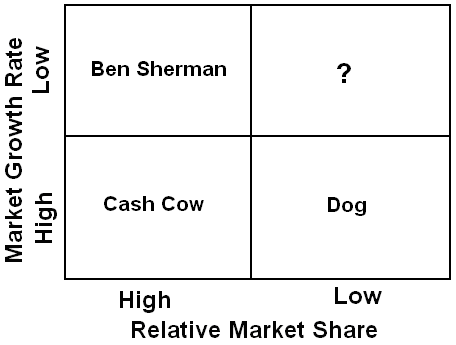
At this point, Cash cows are low- growth, high-share businesses or products that need less investment to support the business, but Ben Sherman requires more investment.
Dogs are low- growth, low- share businesses or products but Ben Sherman occupies a complete inverse position of that.
Question marks are low- share business units in high- growth market. They necessitate numerous resources of cash to carry on their share and move alone increase themselves.
Finally, STAR remains in the highest position of the matrix which is perfect for Ben Sherman products as they occupy the larger market share with a better growth rate than many of its competitors.
PEST analysis of Ben Sherman
Ben Sherman’s products are most popular all over the world. Ben Sherman has designed for attracting and deriving the talent human resource for successful strategic implementation that focuses on base rate of pay, competitive compensation package over time, balance of gifts etc. Personnel committee is important for using outsider consultant for tracking market trends, CRM, evaluation of strategic direction etc. As a multi-national company the environmental issues are too crucial for its development. Ben Sherman’s environmental condition is required to consider by PEST analysis which is as following-
- Political Factors: Global financial crisis creates some uncertainty future expenditure of the customer which may affects on discretionary of customer for example now customers would like to purchase other products than apparel. Thompson, A. et al (2007) argued that investment, investment policy, device supply, operation and growth as well as network development materials can be an important topic of risk, over taxation, rate of exchange, savings of personal intelligence, recession, ups and downs of currencies and the other uncertainties.
- Economic factors: In the year 2008, Ben Sherman’s total assets were $208,829 thousands, operating Incomes were $8,495 thousands, and net sales were $158,927 thousands. Comparing to the previous year it can be found that its net sale is reducing over $9000 thousands. Therefore, it should more careful for target customers. Recent global financial crisis may reduce its sales.
- Socio-cultural factors: As multicultural industry Ben Sherman is more conscious about Socio-cultural factors. Its culture influences on quick and relax decision formulation on a plain, formulated network though it is characterized by huge bureaucracy. It has developed the training and leadership to buildup practical leadership skills. They design different products for different countries for example choice of UK and US customers is different from Japanese customers.
- Technological factors: Information technology is most important factor among other factors for Ben Sherman’s operation system. From design to distribution technology plays vital roles for example designer of Ben Sherman always use modern technology to upgrade their design.
Answer to the Question no b
Christopher, M. G. (2005) expressed that operation management works with the business area associated with goods and service production, responsibility relative to optimum business efficiency. For, that purpose of effective planning, use, timing and control, an operation manager must asses his/ her performance in the context of competitors through the relative importance of goods and services to the target customers. In this regard, marketing of Ben Sherman must influence competitiveness in several ways. Like-
- Ben Sherman identifying customer needs and wants is a centre of competitiveness. This ideal is to achieve a perfect match between those wants and needs and the organization’s goods and services.
- Ben Sherman must consider the pricing because it is usually a key factor in consumer buying decision. It is important to understand the trade- off decisions consumers make between price and other aspects of a product or service such as quality.
- Advertising and promotion are the ways managers can perform potential consumers about features of their goods and attract buyers.
Ben Sherman’s operation can influence competitiveness through a number of factors as shown below-
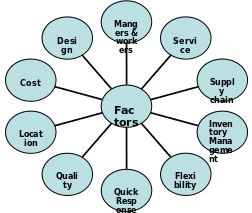
- Product and service design should reflects joint efforts of many areas of the management working together to achieve a match between financial resources, operations capabilities, supply chain capabilities and consumer wants and needs. Also, special characteristics of a product or service can be a key factor in consumer buying decision.
- For Ben Sherman Cost is an important determinant of price decisions, productivity and profits.
- Location can be vital in aspect of cost and for the convenience of customers. Location near inputs can result in lower input cost. Convenient location is particularly important in real sector.
- Quality offers a large competitive advantage since customers are normally willing to give high for a commodity or service if they are perceived as higher feature comparatively better than the competitors.
- Quick response can be ensured in number of processes. Firstly, launching of a new item. Then, quick delivery of current goods after ordering and finally, attention of customer complains.
- Flexibility offers a drive to change. Changes might be alternative features in design, or to the quantity as demanded by people, or a traditional mix of items by Ben Sherman.
- Inventory management can be a competitive advantage by effectively matching supplies of goods with demand.
- Supply chain management involves coordinating internal and external operations (buyers and suppliers) to achieve timely and cost- effective delivery of goods throughout the system.
- Service might essential after- sales of the Ben Sherman’s products. These are perceived by customers as value- added, for example delivery, set- up, assurance work, any technical support, development, and informing the customers and attention to detail etc.
- Competent managers and designers and other employees are the heart and soul of the entire process because if they are experienced and motivated then they can provide a distinctive competitive edge by their skills, proficiency and ideas.
Porter’s Value Chain Analysis
Porter, M. E. (1998) introduced the Value Chain Analysis answer the attack on his Five Forces Analysis. It was criticized that the five-force framework has no implementation methodology that connect the cracks among internal competences and opportunities within the competitive background of an organization. This Value Chain Analysis framework works as a determinant of potential profit of the major players in a particular industry paying attention on industry’s pleasant appearance. There are noteworthy differences in performance among the companies working within the same industry and it could clarify by the company’s contribution in winning strategies or by the explicit competitive advantages.
The Value Chain Analysis engenders the major capabilities and makes distinction of activities those constrain competitive advantage. As a result Ben Sherman’s cost structure should be separated presuming that the cost variation of each behaves differently. Five primary and supportive activities has been considered for Porter’s strength determination such as:
Primary activities
- Inbound logistics for designing activities.
- Operations for plant operating for production.
- Outbound logistics for order processing and distribution channels.
- Ben Sherman’s marketing and sales promotion.
- Service installation.
Support activities
- Ben Sherman’s infrastructure and investor relations;
- Its human resource management,
- Technology development, R&D and IT,
- Procurement of raw materials.
Answer to the Question no c
Introduction
The concept of marketing logistics reveals a deep search individually in marketing and logistical issues. Thus, elaborately speaking, marketing concept identifies specific customer needs by the focus of easy- to –get resources for the purpose of satisfying the unique customer demands. On the other hand, logistics is formally known as a process of the strategic procurement management , moving and preserving the materials, components, finished inventory and relevant flows of information through the company as well as its marketing networks in that way which maximizes the present and future profitability by the cost- sensitive order filling.
Questions regarding the issue
To realize the presented issue, a number of questions may arise:
- How logistics is effective into a firm’s entire marketing strategy?
- How logistics support customer- focused marketing points?
- How logistics is helpful in creating competitive advantage?
- How logistics acts as an interface between marketing and customer service?
- How logistics push requirements across the PLC concept as an integral part of marketing?
The answer of all those questions will be helpful in explaining the “logistics process” in the firm.
Mission of logistics
It acts as a conjunction between market and operations of business. Since, Ben Sherman’s apparel products are sold by domestic chains, retail outlets, specialty stores through out U.S.A by maintaining the superior customer service and logistical flow for positioning the brand and level of privation in the customized clothing market. This systematic concept an be seen as:
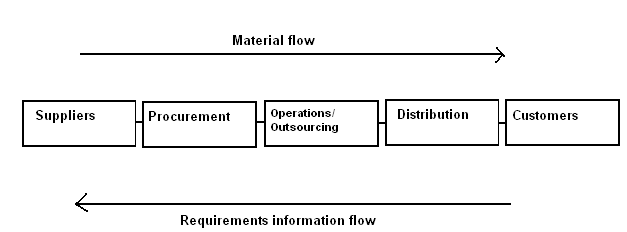
Objectives of marketing logistics
An effective logistics program is helpful in many ways for developing a company’s overall performance and other facilities, like the selected company “Ben Sherman” for the purpose of gaining competitive advantage those causes:
- Productivity advantage.
- Value advantage.
To conceptualize logics as a process for obtaining competitive advantage, it is essential to examine the available options of productivity or value advantage by presenting a simple matrix as below:
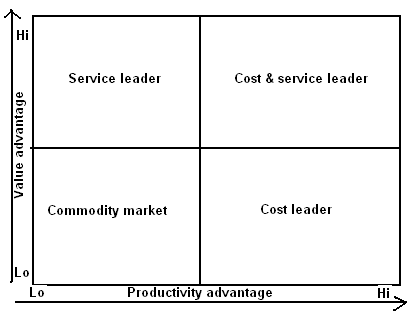
Today, a number of companies are responding through the focus of customer service for achieving competitive advantage like Ben Sherman since it is using videogames as well as electronic networks including face book for retaining and obtaining new customers as a mean of technology because the customers are demanding for high responsiveness, shorter lead time, just- in- time delivery as well value –adding services.
In short, the company’s marketing logistics’ goal can be shown as:
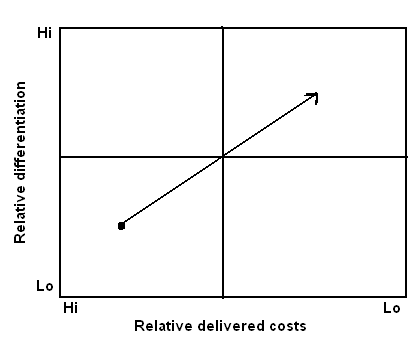
Logistics as a process: For a successful marketing program, products and services availability are very much essential for which a retailer’s resources should be customer oriented and positioned.
There are four economic activities that are responsible for customer value addition. As:
- Process or form.
- Possession.
- Time.
- Place.
Thus, a basic but important issue of integrated marketing is the adoption of marketing mix which can be referred as compilation of tasks requires for attracting the customers through the achievement of strategic goals. Logistics serves as a process for meeting the major requirements of place and time utility that entails that customer demand includes timing and facilities of inventory as well as other services are fundamentally performed. So, customer service is the output of logistical process since it is the visible way for turning customers interest for placing a premium on time and place related facts. Additionally, marketing logistics is the formidable part of all planning as no ownership shifts will occur without filling placement and timing.
Achieving competitive advantage through logistics
Logistics occupies the ability to assists a company in achieving the cost or productivity as well as value facility. The following graph will be helpful to understand that for all companies as exemplifying Ben Sherman:
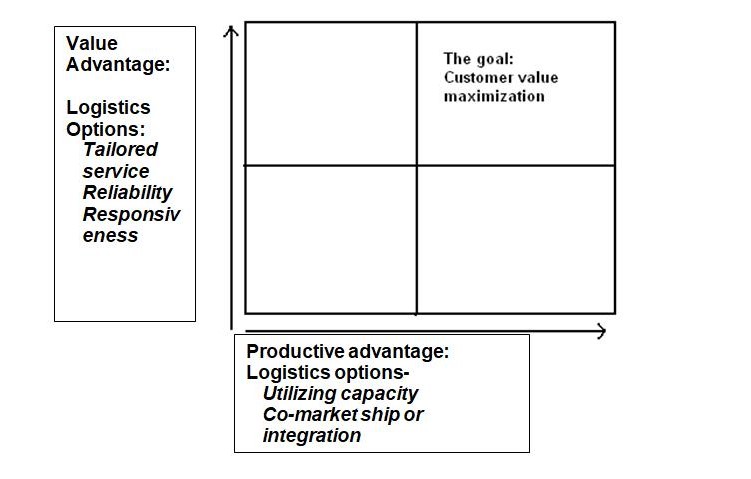
Identifying the marketing and logistics interface: Today, the task of searching excellence has extended for customer handling and goodwill while two factors are prominent-
- Customer expectations are moving forward that can be noticed in all types of market, especially in the apparel market where the company’s major concern is entitled into meeting the updating fashion requirements of people who are more sophisticated than the last 40 or 30 years.
- Slow while inexorable shifts toward ‘commodity’ related markets that means the extended power of company for decreasing technological impacts of ongoing brands since the perception of product variety is crucial- at least to the typical buyers.
Role of customer service in relation to marketing logistics
Since the customer service is helpful in integrating the process of ‘time and place utility’ for offering goods to the customers, availability and distribution are top most effective items for original utilization of an item. Availability involves frequency, reliability, level of stock and cycle time of a required order. For example, Ben Sherman maintains adequate levels of stocks for the purpose of pre- booked orders for meeting the upgrading customers demand for at- once requirements. For the special styled and customized clothing, they keep in- stock replenishment procedure for delivering the shipments to people within a short- period after the order has received. So, it can be said that the company is serving customer service through the interaction of all the forces which are responsible for making the availability program.
So, the components of customer service can be listed as following-
Pre- transaction components:
- Written customer service policy.
- Accessibility.
- Flexibility.
- Structural optimism.
Transaction components:
- Customer order cycle time.
- Availability of inventory.
- Fill rate of order.
- Order status report.
Pre- transaction components:
- Spares availability.
- Time of call- out.
- Tracing or warranting goods.
- Complains or claims of customers.
The influence of customer service and logistics can be viewed as below:

- Brand values Customer service Flexibility Market.
- Corporate image Partnership Low costs supplies share.
- Availability Quick response.
- Customer.
- Retention.
- Superior.
- ROI.
Customer service and retention
Since people don’s buy product but buy benefits, the company, like Ben Sherman is offering more value to the customers by placing the goods in public’s hand rather than storing only with the mega distribution network as following:
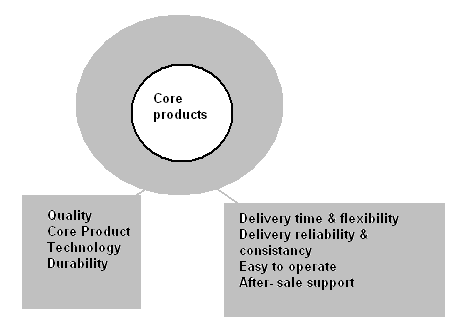
(Source- Logistics & supply chain management, page- 44))
Product life cycle framework: Four stages are-
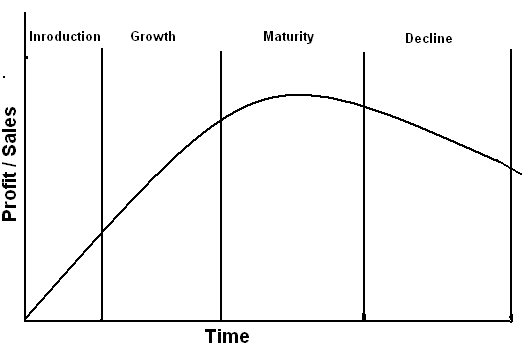
- During introduction phase, flexible logistics, availability of inventory are required for which a retailer may be persuaded of stocking new goods for trial if it is associated by trade promotion.
- Logistics will be shifted to at any cost for performance and profit in growth phase.
- Scrambled merchandising may occur in saturation- maturity.
- The least- unit cost is the motive of decline stage.
Company approach
Ben Sherman is mostly effective in customer value creation process with tailored marketing. It uses a number of technical approaches to be competent in the marketplace. As:
- Promoting the brand through print and moving media and internet campaign.
- Design procedure on the basis of customer feedback and market research.
- Usage of third- party logistics in Hong Kong for the production and sourcing the goods which is help in the reduction of working capital for work- in- process stocks.
- Facilities of internet selling in United Kingdom, United States and Germany.
- Designing and marketing of Arnold Brant brand with the technical mixture of style and luxury.
- Using CMT purchases for Lanier Clothes for keeping engaging manufacturing of customized clothing which helps the company to meet global challenges in satisfying growing customer demand.
- Use of information system at all phases of operations ranging from design to distribution for communicating target customers, vendors and global and national employees. At the same time, many operating parties use websites of e- commerce for the purpose of direct sales.
- Concentration of management team on IS for serving adequate information for resource allocation and forecasting issue since disturbance is possible with hacking, viruses or unethical tasks for lack of correct installation, upgrading, modifying, repair or maintenance system.
- The company is also eligible in preparing the financial documents where a critical balance is maintained for customer disclosure etc.
Answer to the Question no d
After the above discussion and evaluation of worldwide famous brand Ben Sherman, we can now identify a number of factors that are facilitating the company for further expansion as well as others for lagging it behind as risk factors. Some recommendations can be proposed to the management team as forthcoming prospects as following-
- Management should be conscious and forecast the economic trend of target markets since the marketing and sales of any apparel company can be in high risk because of the fall in discretionary income of people.
- Effective competitor analysis since it is facing great threats from competitors and third- parties for a negative impact on sales, low price and low margins.
- Because of the highly changing fashion trends, the company should promote innovative and adoptable goods since the backwardness may result in high inventory pressure and diluted image and down of markets. So, appropriate anticipation, identifying and capitalization are essential through which products can be set into proper distribution network.
- Evolving of new line’s repositioning for cost design, marketing and promotional efforts are helpful for delivering better customer service.
- Major dependence on retail marketing may dilute the total stores and centralized purchase, high customer leverage and straight sourcing can be harmful to the profit margin, so those factors must be modified.
- Significant dependence on long- term contacts associated with long- term customer relationship that would reduce one- time or order- by- order sales emphasized by the competitive effort and quality concern. In short, replacement of strategy of introducing current or new customer segments.
- Formulation of commitments for some months of getting orders from customers and in case of cancellation of that order, the company can reduce the costs of ending the commitment of production and fabric by replacing the extra inventories.
- More emphasize on the utilization of information technology since such kinds of disability can dilute the competitive strength along with slow moving customer service and management needs.
- To reduce regional risks which may occur for the centralized retail options, the company should think for decentralized selling.
- Huge dependence on supplies of raw materials and outsourced producers that are generally situated outside of the country can drop the systematic flow of company in line with inventory unavailability for offering qualified goods to the customers at right time can drop sales and rise costs, it should consider the production ability of individual producers. So, negative features should be understood to deliver the best customer service.
- Necessity to enter in global contacts for hedging price of commodities since the rise or fall in raw materials price can result in delay of delivery badly impacting the customer trust through the additional costs.
- As a number of licenses and trademarks, the company can not assure the continuous flow of such use of names in regarding the quality and consistency.
- At present, it is subject to global economy, political, regulatory, and legal and other types of rules and legislative risks which can negatively impact the importation of goods along with tariffs, taxes and duties. So, the management must focus on strong liaison or public relation aspects with the government of different countries.
- Emphasize several trade agreements like- NAFTA, Andean Trade Preference or Drug Eradication etc. which can benefit the company by lowering the costs of goods sold.
- Since the takeovers incorporate numerous risks involving management strains and costs for acquisition, the company should make a substantial forecasting for acquisition feasibility.
- Close attention should be provided for integrated business channels and operations.
- Major concern to protect intellectual properties or brand values.
- Notable feasibility in operations of international sourcing of materials which may also be impacted by currency devaluation.
- Because of limited distribution channels, inventory management and operating efficiency can not be gained at the desired level, so management must focus on multi- distribution.
- Handling obstacles of opening new retail houses.
Conclusion
Since Ben Sherman is facing multiple risks from many sources, a wise decision making and implementation of those strategies regarding logistics, marketing and overall delivery can able the company to provide more value to the customers.
Bibliography
Bowersox, D. Closs, D., and Cooper, M. B. (2002), Supply Chain Logistics Management, 1st ed., McGraw-Hill/Irwin: London. Web.
Chopra, S., Meindl, P. (2008), Supply Chain Management, 3rd Edition, Pearson Prentice Hall, India. Web.
Christopher, M. G. (2005), Logistics and Supply Chain Management, 3rd Edition, Pearson Education: London. Web.
Cohen, S., and Roussel, J, (2005), Strategic Supply Chain Management, 2nd ed., McGraw-Hill: London. Web.
Coyle, J. J. et al (1995), The Management of Business Logistics: Instructor’s Manual, 6th edition., International Thomson Publishing: London. Web.
Fred, C.P. M. Sollish et al (2007), The Procurement and Supply Manager’s Desk Reference, 1st ed., Wiley, London. Web.
Griffin, R. W. (2006), Management, 8th Edition, Houghton Mifflin Company, Boston New York. Web.
Kotler, P., Armstrong, G. (2008), Principles of Marketing, 13th Edition, Prentice-Hall of India Private Limited, New Delhi. Web.
LTD Management (2008), Lean Supply Chain Management — The Essentials Part 2.
McGraw-Hill Higher Education (2008), System Design: Product and Service Design, Chapter-4, Vol. 6, Seg. 1.
Ming Chuan University (2008), Inventory Management Oxford Industries, Inc. (2008), Annual Report 2008.
Stoner, J. A. F., Freeman, R. E., Gilbert, D. R. (2006), Management, 6th Edition, Prentice-Hall of India Private Limited. Web.
Stevenson, W. J. (2005), Operations Management, 8th Edition, Tata McGraw- Hill Company, New Delhi. Web.
Stevenson, W. J. (2006), Operations Management, 9th Edition, McGraw- Hill Company. Web.
The Times 100, (2008), Ben Sherman, Using the marketing mix in the fashion industry.
Thompson, A. A., and Strickland, A. J. (2003), Strategic Management: Concepts and Cases, 13th ed., Irwin/McGraw-Hill. Web.
Appendix
